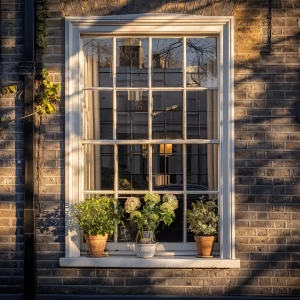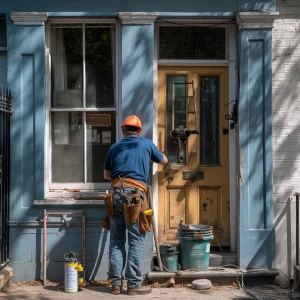Restoring sash windows in London homes boosts their visual appeal, strengthens their structural integrity, and improves energy efficiency. These windows, symbolic of historical and architectural value, are particularly significant in areas steeped in heritage, such as the UK. They demand careful attention to detail and a profound knowledge of traditional craftsmanship to preserve their charm and functionality over the years. This restoration process is essential for maintaining the unique character of London’s residential architecture.
Characteristics and Importance of Sash Windows
Sash windows are a distinct type of window notable for their sliding panels, which provide a unique ventilation method. Typically crafted from timber, these windows are an essential feature of period properties and are prized for their elegant proportions and ability to enhance a building’s natural character. The design of sash windows also involves a complex balancing system consisting of cords, weights, and pulleys hidden within the window frames, allowing for smooth operation and durability.
Preserving these windows is not merely about maintaining appearances; it involves respecting the building’s historical integrity and ensuring that restoration work aligns with the original architectural vision. This is crucial not only for aesthetic continuity but also for retaining the property’s market value. Furthermore, sash windows have intrinsic thermal and acoustic properties that, when properly restored, can significantly improve a home’s energy efficiency while providing effective noise insulation.
Repair Over Replace
The philosophy behind sash window restoration is grounded in the principle of “repair over replace.” This approach prioritises conserving as much of the original material as possible, enhancing sustainability and authenticity. Adhering to this philosophy requires a detailed understanding of the window’s history and construction, allowing for precise and sympathetic repairs that align with the window’s age and style.
Comprehensive Steps in Sash Window Restoration
Restoration typically begins with thorough preparation to protect the property during work. This includes laying down protective coverings and carefully dismantling the window to access all components without causing additional damage. The knockout panels, often used to facilitate easier access, are removed carefully to preserve the window’s original fabric.
Each window component, from the sashes to the glass, putty, and beads, is then meticulously handled and assessed. Old paint is stripped, and the wood is cleaned and checked for signs of rot or distortion. It’s crucial to assess the frame’s squareness and the wood’s structural integrity, as these factors directly affect the window’s functionality and durability.
The next phase involves detailed repairs and replacement of damaged parts. Techniques such as wood splicing, resins and epoxies, and precision glass cutting are employed to restore the window to its original condition. Special attention is given to the joints and cracks, filling them appropriately to ensure the window remains weather-tight and secure. Replacing sash cords and refurbishing pulleys are also critical steps that help restore the window’s smooth operation.
Following repairs, the window surfaces are treated with sanding, priming, and painting or staining to match the original colours and finishes. This protects the window from weathering and ensures that it blends seamlessly with the rest of the building’s exterior.
Reassembly and Finishing Touches
The final step in the restoration process is the reassembly and adjustment of the window. This stage is vital as it involves the precise alignment and securing of the sashes to ensure smooth operation and enhance security. Draught proofing is added to improve energy efficiency, and all mechanical components are lubricated to facilitate ease of use.
By using traditional materials like timber and modern substitutes like epoxy and silicone where necessary, the restored windows retain their historical charm and are equipped to withstand modern environmental demands. Tools such as heat guns, Bahco scrapers, and specialised glazing tools are essential in achieving professional-quality results.
In conclusion, restoring sash windows is a complex but rewarding process that preserves their historical integrity and enhances their functionality. By adhering to a philosophy of minimal intervention and using historically accurate materials and techniques, one can ensure that these timeless features continue to grace our buildings with their unique charm and utility for many years.
Specialised Techniques in Sash Window Restoration
Restoring sash windows is not just about maintaining structural integrity but also about adopting environmentally responsible and health-conscious practices. One of the more specialised techniques in this field involves using a steam box to soften old putty, which facilitates the removal of glass panes without causing breakage. This method is particularly effective as it minimises the need for harsh chemicals, aligning with eco-friendly restoration practices.
Similarly, using an easel to stabilise the sash during repairs is a technique that prevents damage to the wood and ensures precision work can be carried out safely and efficiently. These specialised tools and methods highlight the blend of traditional craftsmanship with modern innovations that characterise contemporary sash window restoration.
Handling of Lead Paint and Safety Measures
Handling lead paint is a significant concern during the restoration of older sash windows. Many historic properties still have original paintwork, which often contains lead—a toxic substance harmful to human health. Complying with Environmental Protection Agency (EPA) guidelines is essential during restoration. This includes employing wet methods for paint removal to prevent lead dust dispersal and using personal protective equipment to safeguard the health of restoration professionals.
Proper disposal of lead-contaminated waste is also crucial to prevent environmental contamination. By adopting these safety measures, restorers protect themselves and ensure that the work site remains safe for the building’s occupants.
Energy Efficiency and Functionality
The functionality of restored sash windows extends beyond their operational smoothness and aesthetics; it also encompasses their role in the building’s energy efficiency. One of the final steps in the restoration process involves draught-proofing and sealing. This is achieved through weather stripping and the installation of airtight sealing solutions, which significantly reduce heat loss and help maintain the internal climate of the property. Such measures are crucial for older buildings, particularly in temperate climates with substantial heating costs.
Additionally, maintaining the hardware—such as pulleys, fasteners, lifts, and stops—is vital for the long-term functionality of the windows. These components are often overlooked during routine maintenance, yet they play a critical role in the windows’ ease of use and security.
Regular Upkeep and Best Practices for Longevity
The longevity of sash windows greatly depends on regular maintenance. This includes prompt repairs of any signs of decay, regular painting, and consistent checking and maintenance of hardware. Professional service is recommended for comprehensive handling, as experts are better equipped to identify and address issues that might not be apparent to untrained eyes.
Adopting a schedule for regular upkeep not only preserves the functional aspects of the windows but also protects the investment by prolonging the life of these heritage elements. Best practices such as using high-quality materials and adhering to traditional restoration techniques are fundamental in ensuring that the windows remain a valuable property feature.
“Regular maintenance of sash windows is crucial for their longevity. Ensuring the frames are rot-free, the glass is intact, and the pulleys operate smoothly can prevent costly repairs. It’s about preserving the window’s function and its historical integrity. A well-maintained sash window can last generations, blending timeless beauty with modern efficiency,” Arthur East, Sash Windows London.
Final Thoughts
In conclusion, restoring sash windows is a detailed process that demands a deep understanding of both historical craftsmanship and modern building practices. By integrating specialised techniques, adhering to safety and environmental regulations, and focusing on energy efficiency, this restoration work not only preserves the timeless charm of the buildings but also enhances their functionality and sustainability.
The careful balance of maintaining historical accuracy while incorporating modern advancements ensures that sash windows continue to be a cherished feature of our architectural heritage. Through diligent maintenance and professional care, these windows can link the past and future, embodying both the history and resilience of traditional building techniques.




